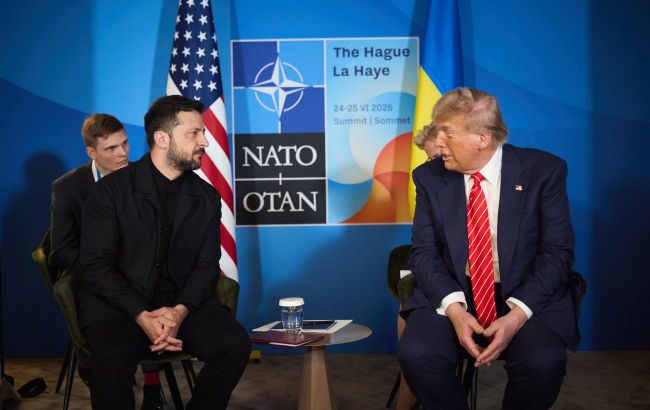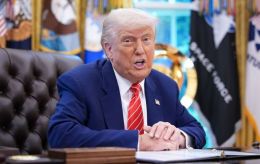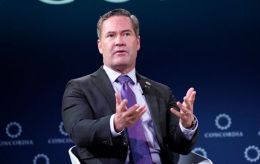Trump and Putin eye talks, Zelenskyy in touch with Europe - Week's digest
 Volodymyr Zelenskyy and Donald Trump (photo: Office of the President of Ukraine)
Volodymyr Zelenskyy and Donald Trump (photo: Office of the President of Ukraine)
This week saw a sharp intensification of talks on ending the Russia-Ukraine war, provoked by US special envoy Steve Witkoff’s trip to Moscow.
RBC-Ukraine reports on the results of the visit, subsequent diplomatic activity, and the prospects of a Ukraine-US-Russia meeting at the highest level.
Key questions:
- What did Witkoff discuss with Putin in Moscow?
- How are the talks assessed in Ukraine and Europe?
- How are Ukraine and Western partners coordinating positions?
- What will determine whether a Zelenskyy–Trump–Putin meeting takes place?
Preparations for negotiations
The negotiation process was triggered by the expiration of the deadline set by Trump for Russia. If there was no progress in talks by August 8, Trump promised to hit Russia with sanctions and trade tariffs. On the eve of Steven Witkoff’s trip to Russia, on August 5, Ukrainian President Volodymyr Zelenskyy had a phone call with Donald Trump. The key topic was ending Russia’s war against Ukraine. Sanctions against Russia were also discussed.
That same day, Trump stated that further declines in oil prices could stop Putin.
“Putin will stop killing people if you get energy down another $10 a barrel. He's going to have no choice because his economy stinks,” Trump told CNBC.
At the beginning of August, oil prices dropped sharply, reaching their lowest level since 2021. The price of Brent crude fell to $66 per barrel.
Trump’s words were reinforced by US pressure on India, the second-largest buyer of Russian oil. Trump imposed secondary tariffs of 25% on the country, after which India began refusing purchases of Russian oil.
Meanwhile, Bloomberg reported that Russian authorities were considering the prospect of an air truce with Ukraine. Moscow could allegedly take such a step to avoid secondary tariffs and US sanctions. According to unnamed sources cited by the agency, Witkoff’s visit to Russia was supposedly Moscow’s last chance to reach a deal with Trump.
Witkoff’s visit to Russia and further talks
In Moscow, Steve Witkoff had a three-hour conversation with Russian president Vladimir Putin. As the Kremlin said, the sides “exchanged signals.”
After meeting with Putin, the US special envoy immediately called Trump, who in turn had another call with Zelenskyy. European leaders also took part in the call. After it, the Ukrainian president said in his evening address: “It seems Russia is now more inclined toward a ceasefire, the pressure on them is working.”
According to Bloomberg, in a conversation with partners, Trump suggested that Putin might agree to peace talks in exchange for discussions on a territorial swap.
The Ukrainian side favors an air truce with the Russians, but there has been no response from Moscow, RBC-Ukraine sources said. Europe’s participation in the negotiation process is still under discussion.
Later, Trump described the Witkoff-Putin meeting as productive.
“Great progress was made! Afterwards, I updated some of our European Allies. Everyone agrees this War must come to a close, and we will work towards that in the days and weeks to come,” he said.
Later, Trump told reporters that the Moscow talks, however, could not be called a breakthrough.
Polish online outlet Onet, citing its own sources, published details of the positions allegedly presented by Witkoff to Putin.
They included de facto recognition of Russia’s territorial gains by postponing the discussion of this issue for 49 or 99 years, lifting most sanctions against Russia, a return to imports of Russian gas and oil in the long term, no guarantees of NATO non-expansion, and no guarantees of halting military support to Ukraine.
However, Ukrainian presidential adviser Dmytro Lytvyn later called the published plan fake.
“It’s doubtful that Witkoff or Ushakov (Putin’s aide Yuri Ushakov — ed.) had time to speak to this outlet (referring to Onet — ed.). Nothing like that was mentioned during yesterday’s leaders’ conversation, and Witkoff said nothing of the sort; he said other things,” Lytvyn stressed.
Nonetheless, other Western media have also reported on the details of possible future agreements. Bloomberg sources said discussions include securing Russia’s control over territories seized during the invasion of Ukraine.
Later, Trump publicly stated that a certain “territorial swap” between Ukraine and Russia was being proposed, without giving details. The Wall Street Journal, citing its own sources, clarified that under Putin’s proposal, which he conveyed to Witkoff, Ukraine would withdraw its troops from the entire Donbas in exchange for Russia’s promise to cease fire.
Future meeting with Putin
Immediately after Witkoff’s trip to Moscow, reports emerged of a possible Trump–Putin meeting. After that, a trilateral meeting with the participation of Volodymyr Zelenskyy was reportedly being considered. According to The New York Times’ sources, Trump mentioned such plans during talks with European leaders.
Fox News sources familiar with the talks said the meeting was allegedly scheduled for next Monday, August 11.
US Secretary of State Marco Rubio noted that the prospect of a meeting depends on progress toward peace in Ukraine. He did not rule out a phone call between Trump and Putin in the coming days.
Ukraine supports the idea of a meeting of heads of state and has proposed three negotiation formats, President Zelenskyy said after consultations with partners on August 7.
“We discussed this in detail yesterday: several bilateral formats and a trilateral one,” the Ukrainian leader emphasized.
Possible venues mentioned in the American and European media included Rome, Budapest, Minsk, and the United Arab Emirates. Ultimately, Trump himself revealed that the meeting would take place on August 15 in Alaska. According to CBS, Zelenskyy might also take part in one way or another. Also, this weekend, Axios sources report, Ukrainian, European, and American officials will gather in London to coordinate steps ahead of the Trump–Putin summit.
Prospects for next week
Coordination of Ukraine’s and Europe’s positions is ongoing. On August 7, the Ukrainian president made phone calls to his counterparts in Italy, Germany, and France. Steve Witkoff also held a video conference with officials from Ukraine and five other countries.
On August 8, President Zelenskyy spoke with Polish Prime Minister Donald Tusk. During the conversation, the Polish leader suggested that Russia’s war against Ukraine could be frozen soon — “sooner rather than later.”
Overall, the negotiation process has indeed intensified, but it still remains rather amorphous and has yet to yield concrete results. Putin’s real intentions are also unclear. The prevailing view remains that Putin is once again trying to string Trump along, stalling for time as in previous rounds of talks.
However, this time, there are signs that the White House understands the danger. On August 8, US State Department spokesperson Tammy Bruce said that Trump would use America’s economic power to achieve results in the negotiations, and that both sides “must step up” to fully stop the conflict.
Undoubtedly, though, the key event not only of next week but of recent years of the war will be the upcoming Trump–Putin meeting in Alaska, as well as the agreements Moscow and Washington will reach — and, of course, the reaction to them from Europe and, above all, Ukraine.

